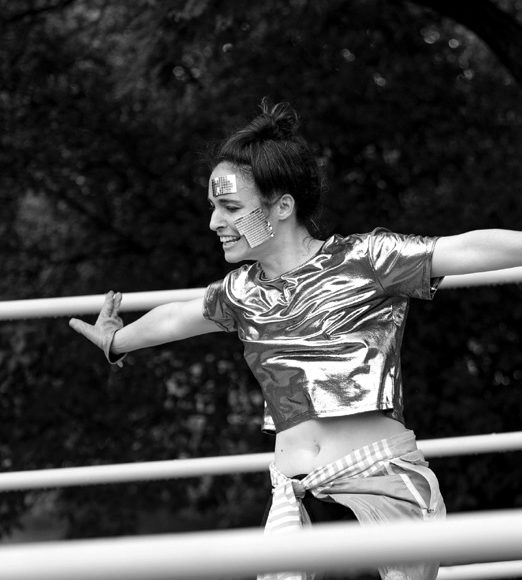BREATHING MEMORIES, TRANSPARENT HISTORIES, #2 – 2020
Dancer and choreographer Gizem Aksu talks about her experiences during her residency in HELLERAU.
“With the breath comes imagination, with the breath comes possibility.” (Sara Ahmed)
How can dance and choreography make life more breathable? How can we, dancers and choreographers, cultivate the consciousness in the breath to fight against the crushing violence of neoliberalism, racism and militarism? These are the key questions that I am asking myself at the end of my residency in HELLERAU. I am happy that I spent the pandemic situation in HELLERAU, accompanied by birds, trees, colorful chemical reactions of the clouds, ghosts of generations of artists, activists and soldiers. I was in a place that reminded me every day that life is present. In this presence I understood very well that “self-isolation” is already a discursive human concept to control the situation. How can we isolate ourselves from the instantaneous, spontaneous, trans-physical life force that the universe offers us in every moment? Even when we are dead, the human body is still part of the biological, chemical, energetic life that is always present. The human body always points beyond itself. This transcorporality is what makes our body alive. The pandemic experience reminds me how the human body is connected to and dependent on its environment and its surroundings. Our flesh is not the border but the passage for this transcorporality, our breath is not only mechanical but also ecological. The relativity of the human body can be read through the breath. Nevertheless, it may be challenging to recognize this transcorporeal existence within the permeability of the breath, because it is difficult to perceive the transparent quality of “seemingly opaque bodies, including the human body”. Many sufferings, traumas, limitations and pandemics are written in the transparent presence of the breath. Transparent stories of suffocation, oppression, struggle, conflict and resistance. In this context I developed the projects “Archive of Feelings: HELLERAU”, “Self-isolation” and “A Breathing Poem” during my residency. I was not always so lucky: it was traumatic to “isolate myself” in 2016 while bomb explosions were taking place in Istanbul. Who can’t breathe? Whose life can breathe? Breathing is not only to be understood ecologically, but also sociologically, politically and economically. Rukeli Trollman became my spiritual friend during the isolation in Dresden. I often visited him in his memorial in the garden, created by BEWEGUNG NURR. It was absolutely breathtaking to learn boxing from him, as I once learned the folk dance of the Sinti and Roma. I wanted to create a physical, sweaty performance to remind us of his fighting history. In my perspective, body, spirituality and politics intertwine in movement. The body suffocates when the system reduces its potential only to physical labor to make profit and reproduce hegemonic or naked violence. This kind of spiritual encounter allows us to learn from each other’s history, to traverse the linear history of time and space, and to meet beyond the Cartesian understanding of the body. Bodies disappear, but transparent traces of our bodies can remain. My time in HELLERAU was characterized by the search for such traces. I would describe my method of research as microscopic attention that went in search of transparent traces: listening to the silence of history and witnessing the presence of architecture. Every morning I looked at the Yin-Yang symbol on the roof of the Festspielhaus. I remembered how much we are connected and interdependent, I tried to feel the non-dual presence of exhalation and inhalation. I tried to feel the non-duality in my trans-bodyhood. I tried to inhale hope, to push more for justice. I believe that dance and choreography can cultivate consciousness in the breath. Instead of surrendering to the flood of information in the global panic situation, I tried to feel my presence. The local space navigated my body, my mind and my soul in unexpected directions. The localization of myself gave me a concrete ground on which to begin my artistic research. I let myself be moved by the local conditions. Then I became transparent. Then I became breath. For all this, many thanks to the European Center of Arts HELLERAU, Center for Inspiration, Center of free speech, Home for self-isolation. Center for social community, Center for spiritual purification, Center for creative inhalation, Center for artistic exhalation.
Gizem Aksu was in HELLERAU from March to June 2020 as part of the residency program “Be Mobile – Create Together” and worked here on her project “Archive of Emotions”, among other things.
“Be mobile – Create Together” is supported by the Institut français de Turquie, Dutch Embassy in Turkey, Goethe-Institut Istanbul and Istanbul Foundation for Culture and Arts (İKSV).
More information at www.hellerau.org/residenzen


